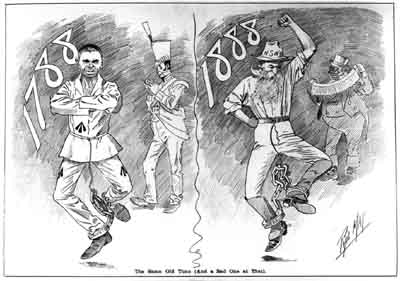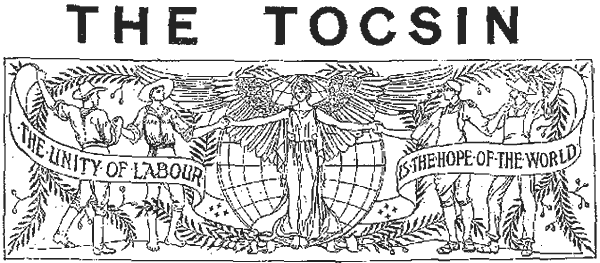
FEDERATION
John Hirst has hailed the federation of the six Australian colonies as 'the greatest political achievement in Australian history', and has expressed his amazement that 'few [Australians] ... know or honour [their nation's] origins' (Hirst, 1999, p. 243). Despite the obvious defence and trade advantages to Australia of being under one government, the colonial politicians were reluctant to hand over any of their powers, in much the same way as State politicians are today. Politicians across the spectrum argued about whether the proposed political structure gave too much or too little protection to the smaller states.
In 'The Same Old Tune And a Bad One at That' cartoonist Phil May satirises
Australia's continued economic dependence on Britain.
In The Bulletin, 21 January 1888, p.10. By permission of the National Library of Australia.
Most of the nationalist arguments, however, were left to groups such as the Australian Natives Association, the strongest advocate of union, who pursued the 'One Nation, One Destiny' theme. Nationalism and loyalty to the Empire were sometimes seen as mutually exclusive.
The 1880s had seen the rise of the Imperial Federation movement to form some type of political and defence alliance among the British colonies of South Africa, Canada, New Zealand and Australia. All were colonised by the British who subjugated an indigenous population and claimed its territories; each had a low population, a weak defence force and an emerging national sentiment. Imperial Federationists wanted to unite Australia 'as one state among others in a great and permanent Federation of the English-speaking Empire' (Irving, 1999, p. 29).
Most Australians, however, preferred an Australian Federation to an Imperial one. The Bulletin, for example, believed that an Imperial Federation would disadvantage Australia commercially. Others pointed out that to be part of such a Federation, Australia would firstly need a national government. To overcome the dilemma of how to be nationalist and pro-Empire at the same time, proponents of Australian Federation used the concept of the 'crimson thread of kinship' quoted by Henry Parkes, past Premier of NSW. (Irving, p. 29; Hirst, p. 243; de Garis, 1980, p. 250). Australians could be both patriotic and British, because Australians were 'Britons'. Obviously, this concept was strongly influenced by ideas of racial 'purity' and of maintaining Australia as a society of Britons. One of the manifestations of this sentiment was an aggressive imperialism that envisaged Australia as 'the seat of a mighty [Australian] empire under the banner of the Anglo-Saxon race'. (Hancock, 1930, pp. 65-66).
Apart from ideas of kinship with the British Empire, there were other ideologies developing in Australia in the closing decades of the nineteenth century, which would influence the Constitution of the new nation. By the 1890s, Sydney and Melbourne had become centres of radical thought embracing the ideas of feminists, single taxers, socialists, anarchists and republicans. In an era when the works of Karl Marx were little known in the Australian colonies, Edward Bellamy's Looking Backward was by far the most popular exposition of socialism. Bellamy's ideas pervaded many ideologies of the era. (Scates, 1997, p. 170). Although the various groups and individuals who met and discussed such works as Bellamy's differed greatly in their ideas and methods, they found common ground in the 'social problem' of inequality. Why, they asked, 'in an era of unprecedented human achievement, was there suffering and want?' The answer to these questions was commonly held to be that labour alone created the wealth and that the rich maintained their wealth 'through the power of monopoly, their exclusive ownership of the means of production forcing the poor and landless to toil for them'. (Scates, pp. 136-158). It was out of many different ideas, and groups, but with a common outrage against the injustices done to the poor, that the ALP formed in 1891, with branches (initially known as Political Labor Leagues) in Queensland, New South Wales, Victoria and South Australia (McMullin, 1991, pp. 6-7).
During
the next decade, factory acts were passed in New South Wales, Victoria
and Queensland, with the Victorian one being the most comprehensive. The
Victorian Parliament set a minimum wage, prohibited children under 13
years from working, and granted a maximum working week of 48 hours to
boys under 16 years and women. In the late 1890s, numerous Acts were legislated
to regulate industry, including the Employers' Liability and Workers'
Compensation Acts of 1897, and various mining regulation Acts (Gollan,
1976, pp. 79, 158-159). During this time also, campaigns to grant the
vote to women were successful in South Australia (1894) and Western Australia
(1899). Consequently, pre-Federation debates included much on representation.
There were arguments about how the States would be fairly represented,
and whether the more populous States should have more influence than 'smaller'
States. Other discussion centred upon equal representation in areas such
as the role of women, both as voters and as Parliamentarians, the place
of unions and the development of an arbitration system to facilitate smooth
industrial relations. The inclusion of powers was not always seen as progressive.
The Western Australian Church News, for example, complained that the inclusion
among federal powers of jurisdiction over marriage and divorce would expose
Western Australia to the more 'liberal' laws of the eastern colonies.
The Brisbane Worker 'argued that pensions and arbitration powers were
"really matters of domestic concern", that had been redefined
as federal powers to curb the tendencies of progressive states' (Irving,
p. 95).
In 1897 and '98, the Tocsin - a
weekly newspaper published by the Left Wing of the Victorian Political
Labor League (PLL) - warned that Federation was not inclusive of workers'
interests. The Tocsin reflected views which Curtin, as a young man, adopted
and developed in his own writing. The paper published the PLL platform,
which was based on the Chartists' demands of one vote, one value, payment
of Members of Parliament, and annual parliaments. To these the PLL added
provision of the old age pension; the reform and ultimate abolition of
Legislative Councils; an eight-hour working day; a universal minimum wage;
the abolition of Sunday labour, and mining law reform. The paper advocated
that a Federal Constitution be drawn up by 'a Convention elected directly
by the People of all the States' and then be 'submitted to the people
by means of a referendum' (Tocsin, 9 October 1897, p. 6).
The paper also pledged itself to maintain 'a watchful attitude towards Federation'. In an article criticising the power of the United States' Constitution, the Tocsin (21 October 1897) asserted that in the US it was 'not the living people who governed but the long dead men who wrote the Constitution'. Australia, therefore, would be wise to avoid setting up a Senate 'in which a minority of the people shall be able to dominate the majority'. In preference to a political federation, in fact, the Tocsin called for the establishment of a Trades Federation to enforce an 8-hour working day in every State and strengthen trades unionism.

No time should be wasted. A Trades Federation is infinitely more important to the vast majority of workers than a political Federation, even of a good type; for, whether political Federation comes or not, Australian Unionism may be in its death-struggles before many years are over, if a sound scheme of Trades Federation is not soon in active operation
(editorial, 5 May 1898).
The Tocsin ran a series of articles on the 'dangers of the Federation Bill', summarised in a list of 28 objections which readers were urged to vote against (Tocsin, 19 May 1898). The objections included a reiteration of the principle of opposing a States house, which provided for equal representation of 'grotesquely unequal states' and denied 'majority rule'. It claimed that the 'medley of franchises' would disenfranchise thousands of Australians - the opposite actually seems to have been the case, particularly for women - and that, under the proposed Constitution, payment of members and vote by ballot could be abolished. Also, the Constitution made no provision for a national referendum (or any other method) to solve deadlocks, and it allowed the Federal Army to act as strike breakers, and Queensland to join the Federation without abolishing slavery.
The Tocsin also expressed anxiety about the powers given to the Governor General. As might be expected of a 'Socialist rag', the paper's attitude to the British Empire was at best irreverent, and sometimes quite scathing, as exemplified by criticism of Britain's part in the Boer War (1899-1902), and attitudes towards the British royal family. A particularly strongly worded editorial on 17 January 1901, referred to the 'leprosy of jingoism'. On the death of the Queen, the Tocsin reflected that Victoria must have been an extraordinary person to have survived so many years of the 'withering artificiality of Court life' and 'the handicap of the gruesome hereditary infirmities of Royal blood'. The paper expressed a regret that the Queen was 'not born to a better fate than to be the occupant of a throne' (Tocsin, 24 January 1901). This guarded respect for the royal person juxtaposed with tirades against imperialism was also a feature of Curtin's writing in the Westralian Worker during the 1920s.
By 1905, Tocsin was publishing the revised PLL platform each week. The seven planks of Labor's Fighting Platform were:
- maintenance of a White Australia
- compulsory arbitration to settle industrial disputes, with provision for the exclusion of the legal profession
- old age pensions
- nationalisation of monopolies
- a citizen defence force
- restriction of public borrowing
- navigation laws [To provide for the protection of Australian shipping against unfair competition; to register all vessels engaged in coastal trade; to ensure efficient manning of vessels; to ensure that ships carried adequate safety equipment, and regulate working hours.]
The platform also advocated establishing a federal patent law, uniform industrial legislation and a Commonwealth Bank. It is worth noting that most of this platform would have been a nonsense without the political and historical fact of Federation. As John Cain, past Premier of Victoria, pointed out in a 1996 lecture commemorating Curtin, Federation was of considerable importance in shaping the Australian Labor movement. Some of the major tenets of Federation were: white Australia; industry protection; civilised wage and arbitration system; state paternalism, and imperial benevolence (Cain, 1996), and the first three of these were advocated by Labor. Furthermore, from its inception, Labor was intended to be a national party.